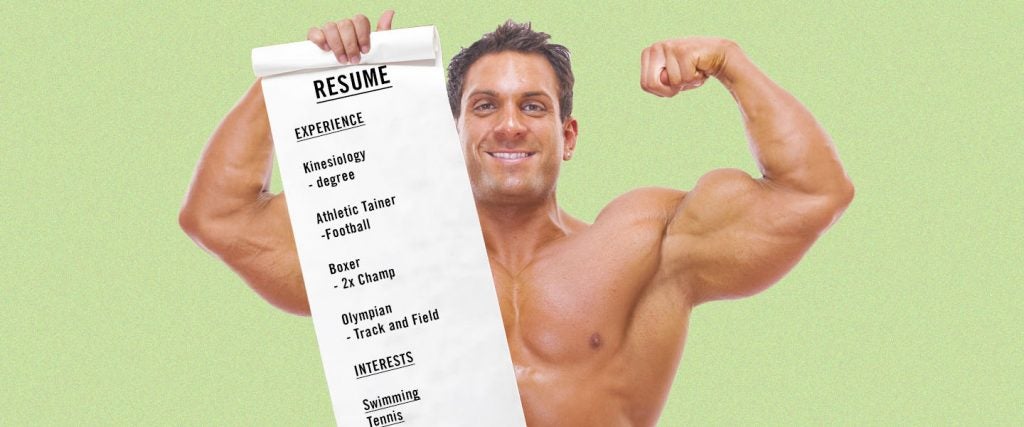Selecting an ideal personal trainer is usually a bit of a crapshoot. More often than not, you’re going to find yourself stuck with whatever part-time actor or full-time eighth grade gym teacher is looking to scrape together some extra cash to supplement the income (or lack thereof) from what they would consider their true calling. When this transpires, you might find yourself at the mercy of someone who places you low on their priority list.
But, for the sake of argument, let’s assume that your gym of choice is a training utopia, filled with an assortment of skilled, career trainers, all of whom are champing at the bit to be the conveyance through which you’re carried to all of your fitness dreams. It’s like a personal training Tinder, where you can swipe right and left based on a trainer’s background and list of accomplishments. All things considered, who do you choose?
There are so many qualified candidates to choose from! What kind of athletic background should I make sure they have?
What you’re looking for is someone who is likely to have experienced the greatest diversity of training tactics and nutritional approaches applied within their sport, and within their sphere of immediate influence. This means we can begin by eliminating participants in sports that tend to be one dimensional in terms of the body types and ideals associated with them. For example, your ideal personal training match is unlikely to be a tennis player, because the bulk of the instruction tennis players receive is going to be about maximizing power, speed and quickness within a certain body shape, and with one focus in mind. Most of them won’t be able to tell you a whole lot about bulking up your shoulders or maxing out your squats, because most of them are going to be of roughly the same build once they’ve reached their primes.
What about boxers? They’re usually in incredible shape.
Many of them are, and they can probably also teach you quite a bit about calisthenic training, running and rope jumping. While you’re at it, you might even find yourself with a pair of well-educated fists. Also, even if they’ve spent the bulk of their time fighting in a single weight division, and therefore only doing what’s necessary to optimize their performance at a certain weight, most boxers have probably been in the gym paired and partnered with fighters of all shapes and sizes, and understand the sort of fitness training and dieting required to move up and down in weight successfully while still packing the requisite punch.
Oh, I get it! I want someone who has experienced plenty on their own, but also seen and heard a lot as well.
Precisely. It’s for this reason that football players are also likely to have a deeper well of knowledge to draw from as personal trainers as opposed to powerlifters. Under normal circumstances, football trainers will be on teams where the players come in all shapes and sizes, with different on-field responsibilities. It should come as no surprise that the training regimens of football players can vary greatly by position, with linemen being asked to maximize their size while cornerbacks are tasked with prioritizing speed and agility. Yes, football players are almost always asked to maximize their strength at their respective sizes, but they’re also likely to have gleaned the differences between training and eating exclusively for size, and training and eating with the objective of minimizing the accumulation of excess body mass.
This is why a trainer from a track-and-field background should also be high on your draft board. These athletes are required to maximize performances of all different types. Sprinters are looking for explosive power in a body optimized to achieve high speeds over short distances. Distance runners are looking for durability in bodies that are weighed down by the minimum amount of surplus weight. Shot putters, hammer throwers and discus throwers are looking to maximize total-body (but primarily upper-body) explosiveness within a relatively small space, while javelin throwers, with the benefit of a run-up, are maximizing the transference of leg speed to arm propulsion.
In essence, a track-and-field team is loaded with individuals who need to hone their bodies in countless ways, with varying training tactics and dietary means to achieve those specified ends. It’s unlikely that you can come to them with an ideal in mind that they can’t advise on you how to achieve.
But what about swimmers? Isn’t that basically like track and field in the water?
Not really. The training for competitive swimming is highly specialized even within its own world. The very best swimmers often possess downright freakish physiques, and their in-water training and weight training is often tailored to maximizing the momentum and minimizing the water resistance of specific strokes. Or more simply put, a lot of the training techniques intended to squeeze every last second out of your 200 breaststroke will only be so beneficial to you if you aren’t built for swimming, which is to say nothing of how useless they’ll be if you can’t swim at all.
I also wouldn’t entrust the average swimmer with my goal of packing on 20 pounds of muscle, since it’s rare to find a swimmer who’s specifically training to add size; again, they’re usually training to add strength that’s going to be applied in a stroke-specific way, with stroke patterns often tailored to match the unique body attributes of the swimmer using them.
Interesting. I guess I shouldn’t always pick the trainer who looks the fittest.
Let me put it this way: You need someone who can tell you what exercises to do, and why you’re doing them. It’s all well and good if they have the build to go with it, but in the end, it’s your reflection in the mirror that’s the biggest reflection of them.

